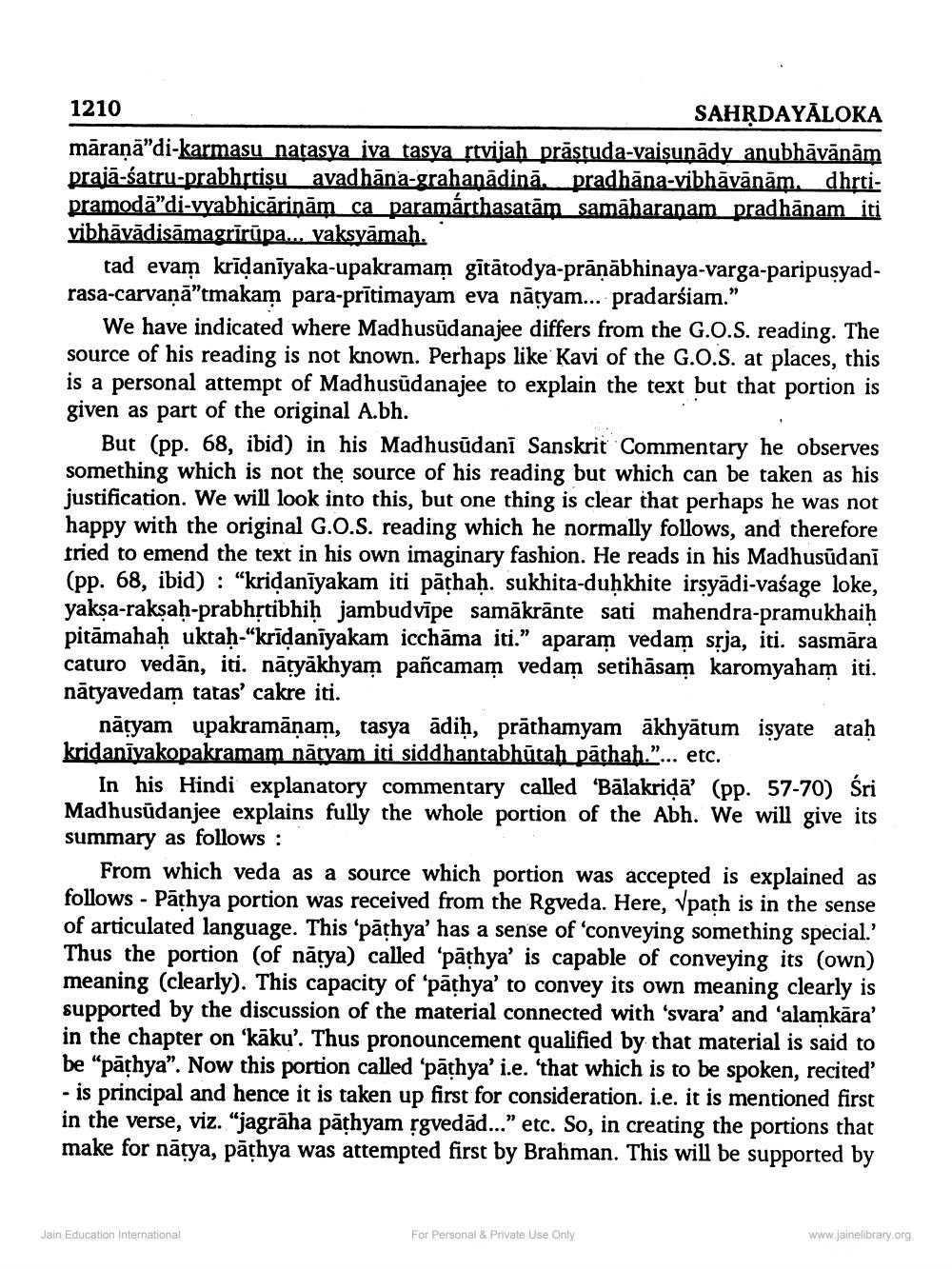________________
1210
SAHRDAYĀLOKA
māranā"di-karmasu natasya iva tasya rtvijah prāstuda-vaisunädy anubhāvānām prajā-satru-prabhrtisu avadhāna-grahanādinā. pradhāna-vibhāvānām.dhrtipramodā”di-vyabhicāriņām ca paramárthasatām samaharanam pradhānam iti vibhāvādisāmagrirūpa... vaksyāmah.
tad evam krīdanīyaka-upakramam gitātodya-prāņābhinaya-varga-paripusyadrasa-carvaņā"tmakam para-prītimayam eva nātyam... pradarśiam."
We have indicated where Madhusūdanajee differs from the G.O.S. reading. The source of his reading is not known. Perhaps like Kavi of the G.O.S. at places, this is a personal attempt of Madhusudanajee to explain the text but that portion is given as part of the original A.bh.
But (pp. 68, ibid) in his Madhusudani Sanskrit Commentary he observes something which is not the source of his reading but which can be taken as his justification. We will look into this, but one thing is clear that perhaps he was not happy with the original G.O.S. reading which he normally follows, and therefore tried to emend the text in his own imaginary fashion. He reads in his Madhusudani (pp. 68, ibid) : “kridanīyakam iti pāthah. sukhita-duhkhite irsyādi-vaśage loke, yaksa-raksah-prabhṛtibhiḥ jambudvīpe samākrānte sati mahendra-pramukhaih pitāmahaḥ uktaḥ-"krīdaniyakam icchāma iti.” aparam vedam seja, iti. sasmāra caturo vedān, iti. nāryākhyam pañcamam vedam setihāsam karomyaham iti. nätyavedam tatas' cakre iti.
nāryam upakramānam, tasya ādih, prāthamyam ākhyātum isyate atah kridanīyakopakramam nātyam iti siddhantabhūtah pāthah."... etc.
In his Hindi explanatory commentary called 'Balakrida' (pp. 57 Madhusudanjee explains fully the whole portion of the Abh. We will give its summary as follows :
From which veda as a source which portion was accepted is explained as follows - Pāthya portion was received from the Rgveda. Here, Vpath is in the sense of articulated language. This ‘pāțhya' has a sense of conveying something special.' Thus the portion (of nătya) called 'pāthya' is capable of conveying its (own) meaning (clearly). This capacity of 'pāthya' to convey its own meaning clearly is supported by the discussion of the material connected with 'svara' and 'alamkāra' in the chapter on ‘kāku'. Thus pronouncement qualified by that material is said to be "pāthya”. Now this portion called 'pāthya' i.e. 'that which is to be spoken, recited' - is principal and hence it is taken up first for consideration. i.e. it is mentioned first in the verse, viz.“jagrāha păthyam rgvedād...” etc. So, in creating the portions that make for nātya, pāthya was attempted first by Brahman. This will be supported by
Jain Education International
For Personal & Private Use Only
www.jainelibrary.org




